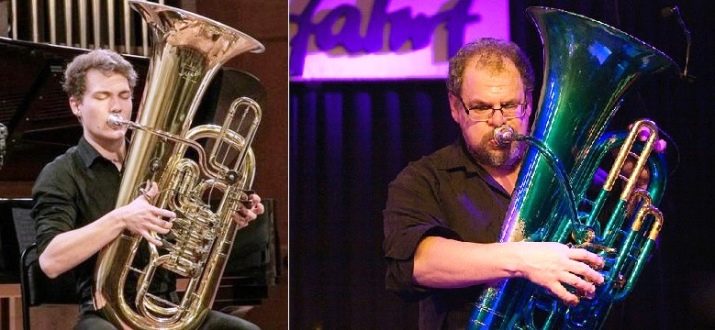Tuba: description and playing the instrument
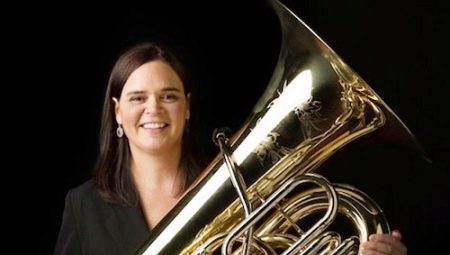
Among the many wind instruments that perform different functions in orchestras and other musical groups, there is one on which the bass part of the composition is almost always played. This instrument is the tuba, which is well known to many of us by its appearance. True, not everyone knows what this tool is called, but visually it is recognizable. Now there is an opportunity to get to know him better.

What it is?
The tuba belongs to the brass types of musical instruments. Mostly it is used in brass bands, as well as when performing symphonic music, performing the function of a bass instrument in brass instruments. Before its invention in the middle of the 19th century, bass parts in an orchestra were assigned to bass trombones. She is often present among groups specializing in the performance of jazz and chamber works.
The tuba looks quite massive, having a very long pipe, coiled into a seemingly inconceivable labyrinth and expanding in the course of its movement towards a huge outlet funnel.
If the copper tube of this instrument is straightened, then it can reach (depending on the variety) a length of about 5-6 meters, which is twice as long as, for example, a tenor trombone.
The weight of the instrument is also decent, so it is played mainly while sitting on a chair.
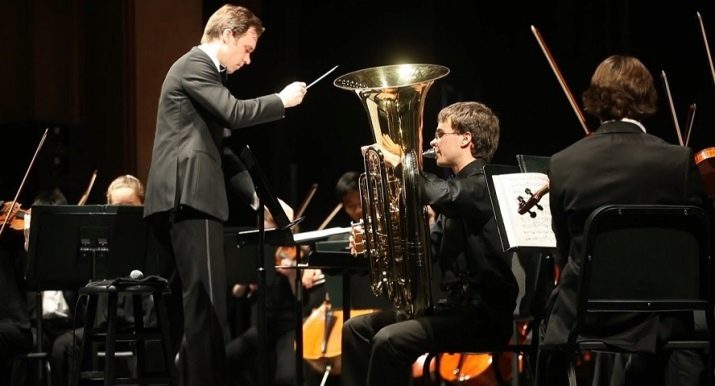
If it becomes necessary to play while standing or in motion, then support straps are used.
It must be said that composers also write solo parts for tuba (of course, as part of an orchestra). In these cases, the musician often has to perform solo in a standing position in order to have more freedom of action.
Instrument device
As already mentioned, the tuba consists of a long copper pipe expanding towards the socket, which is folded several times. The expansion ratio of the pipe from its beginning to its outlet is approximately 1:20. It can have from 3 to 6 valves in its design. Valves in wind instruments are used to open additional channels for the movement of air flow, as a result of which the length of the air flow increases, which, in turn, lowers the sound of the instrument. Most often there are four of them, often five, and the sixth can be found either in old instruments or in specially made to order. The function of each of the valves is as follows:
- when the first valve is pressed, the sounds of the natural scale produced by the musician are reduced by 1 tone;
- the second valve in order lowers sounds by a semitone;
- the third valve lowers the scale by 1.5 tones;
- the fourth valve is called "quarter-valve", that is, it lowers sounds by a pure fourth - 2.5 tones;
- the fifth valve - correcting - is able to lower the scale by 3/4 of a tone;
- the sixth valve was considered transposing, but it is absent on modern models, so the tuba nowadays belongs to non-transposing musical instruments.
It turns out that when you successively press the first three valves, the total sound will decrease by 3 tones, and if you press a quarter valve, the decrease will be 5.5 tones (a large seventh).
You can understand the structure of the described musical instrument by the following image:
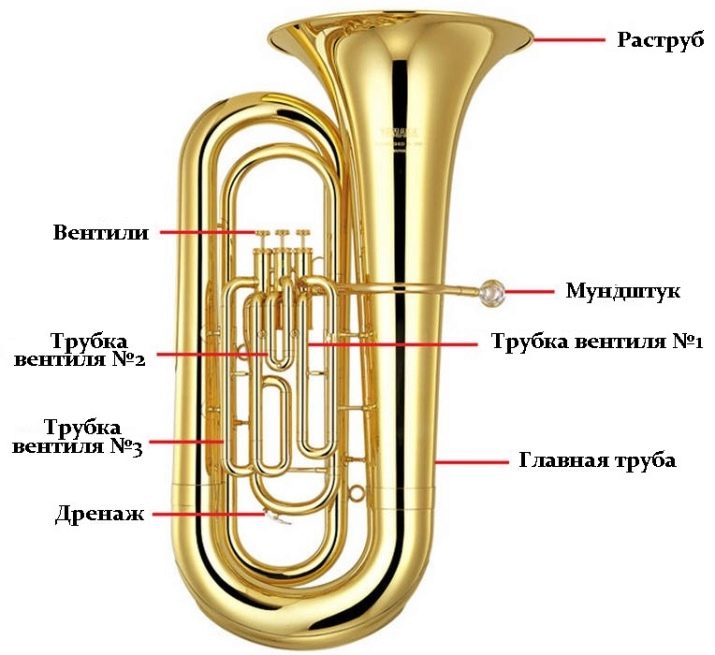
The picture shown shows a model of a tool with three valves, but everything else is present in any design. Valve mechanisms can have a very different appearance, including the location of their tubes. In addition, mouthpiece placement is also not standard on all models. Much in the design also depends on the size of the tool.
The sound change due to valves (valves) is as follows.
- The initial state of the valves is closed. In this case, the air that is pumped into the channel of the main pipe by the musician's exhalation when playing a particular sound, bypasses the valve tubes, since they are closed.
- When the valve is pressed with the same air flow, the valve tube opens, where, naturally, part of the air flow rushes. The length of the air column increases, the pitch decreases, depending on which valve of the four is activated.
- When one more (or more) valve is pressed, an even greater elongation of the air column occurs. The sound is further lowered again.
- When the valve (s) are closed, the pitch is restored.
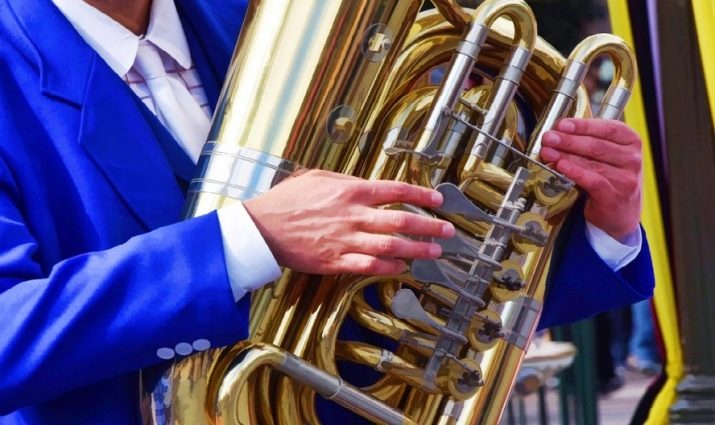
It should be noted that the quarter valve is used very rarely - in some cases, when it is necessary to play several notes in a very low register. That is why an instrument without a fourth valve is quite possible to do in small brass bands. But for a symphony orchestra, you should still buy one tuba with all five valves - serious music does not tolerate the substitution of original sounds written by the composer.
Varieties
Tuba is presented in our time in several varieties according to the range. In total, they make up a scale extending from the note "D" or "E" of the counter octave to the note "C" of the second octave. Starting from the instruments of the lowest register, the tuba have the following names:
- contrabass "Bb" or "C"which have approximately the same range of sounds: the first - from the "mi" of the controctave to the "B-flat" of the small octave; the second - from the "G-flat" of the controctave to the note "C" of the first octave;
- bass "Eb" or "F" with an approximate range: the first - from the note "A" of the counter octave to "E flat" of the first octave; the second - from the "si" of the controctave to the "fa" of the first octave;
- tenor with a very different range of sounds from the beginning of a large octave to the beginning of the second.
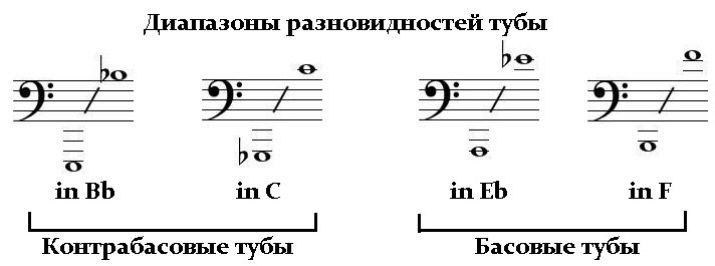
Here it is necessary to clarify the following point: brass instruments, including a tuba, do not have exact boundaries of their ranges, therefore the above ranges of varieties of tuba are indicated through the word "approximately".
The full range of tuba, which is quite enough for playing most of the popular melodies for brass bands, can be provided with an ensemble of several types of this instrument: double bass, bass and tenor. The sound of the instruments in the middle registers is very dense, beautiful and powerful.

Technique of the game
Playing the tuba, which has a massive and long pipe, requires a musician to train his own breathing for a long time and to have remarkable general health. Low and high register sounds are especially difficult to play. Sometimes the tuba player has to change the breath for each low note, and the high notes are characterized by intonation instability.
Fast passages often do not sound very clear, and legato on low sounds is out of tune. The best timbre is observed in the middle registers of each of the varieties of this instrument. The extreme sounds of the ranges are quite problematic for beginners.
Here is the fingering of the tuba:
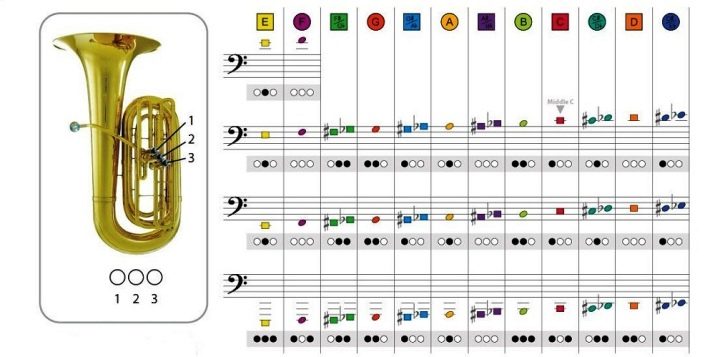
If there is a decision to learn how to play this instrument, which is very necessary for wind orchestras and ensembles, then you can find an experienced teacher in the case when there is no experience of playing wind instruments at all. Another option is to purchase a tutorial or a tuba school if you still have experience.
For the initial training, it is better to buy not a complete instrument, but a 3/4 size (model "Eb" tuning). For those who are closer to solo playing at higher notes, the instrument with the highest tuning “F” will do. True, its cost is quite high.
However, even a beginner learning to play the tuba musician who has played another wind instrument for a long time will need a few lessons from an experienced tuba player. He will need them to master a more professional performing level, to learn and comprehend the nuances of this instrument.
Only a professional will tell, demonstrate and teach how you can play trills (with which valves and lip positions on the mouthpiece), how to train your lungs for more complex work, and so on.
And if only to master the methods of holding such a massive instrument usually requires advice from experienced tuba musicians, then what can we say about the technique of fingering and breathing playing, as well as mastering its articulatory nuances. Most likely, in the orchestra, not every musician who is next to the tuba player knows that when playing the tuba, one should hold the bell up, otherwise the timbre of its sound will change for the worse. In other words, it is only under the supervision of a professional tubist that one can properly learn how to play the instrument.
